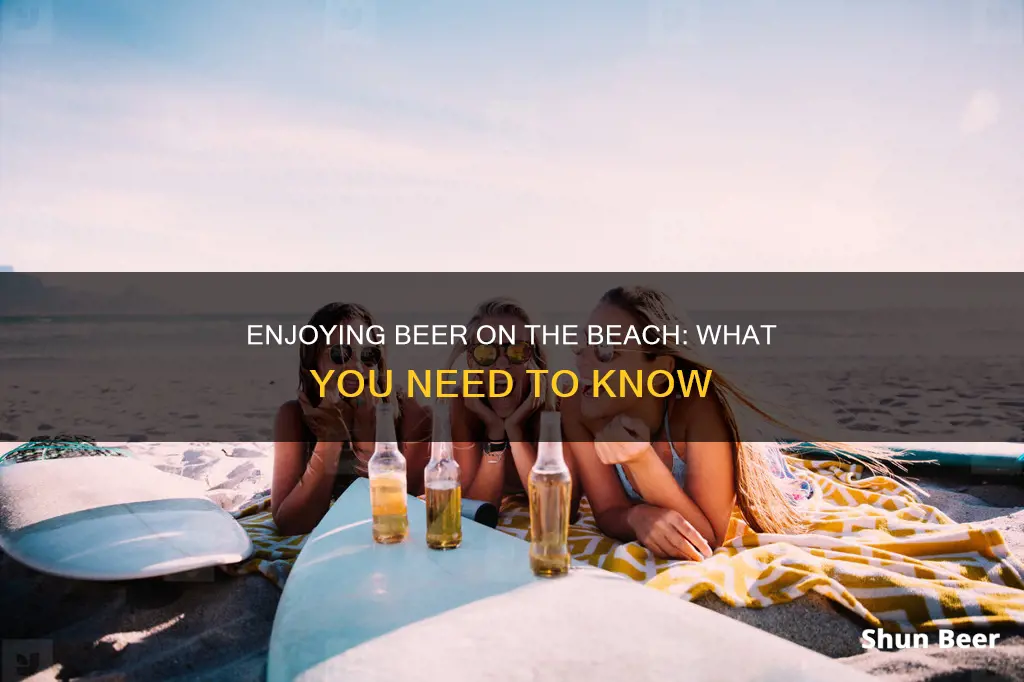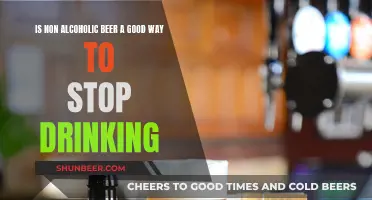
Whether you're on a tropical vacation or a local beach, enjoying a cold beer with the sand between your toes is an appealing prospect. However, drinking alcohol on the beach is not always permitted, and rules vary depending on your location. While some beaches allow drinking in designated areas, others have strict regulations prohibiting alcohol consumption. These rules may also be influenced by local laws, such as the legal drinking age and open container restrictions. Additionally, glass bottles are often banned on beaches to prevent broken glass, with drinkers encouraged to use plastic cups or bottles instead. So, before you pack your cooler and head to the shore, it's essential to familiarize yourself with the specific regulations of your chosen beach to ensure you abide by the law and avoid any unwanted run-ins with the authorities.
| Characteristics | Values |
|---|---|
| Location | This varies depending on the country, state, and city. For example, in the US, drinking on the beach is allowed in Carmel Beach, California; Panama City Beach, Florida; and Haulover Beach, Miami, Florida. |
| Container Type | In some places, open containers are allowed. However, glass bottles are often prohibited, with plastic bottles or cups being permitted. |
| Time of Day | In some locations, drinking is only allowed during certain hours, e.g., between 5 a.m. and 8 a.m., and 6 p.m. to 1 a.m. |
| Day of the Week | Drinking may be prohibited on certain days of the week or during specific months. For instance, at Treasure Island, Florida, alcohol is banned on the beach during the weekend. |
| Age Restriction | The legal drinking age must be considered, as it varies by country. |
What You'll Learn

US beaches where drinking is legal
Drinking on the beach sounds like a dream, and while it is illegal in most places, there are some US beaches that allow it. Here are some of the beaches where you can legally drink:
Florida
Florida has some of the world's best beaches, and while public consumption of alcohol is generally prohibited in the state, there are some exceptions. Several beaches in Florida allow drinking, but with certain restrictions. Some beaches only permit alcohol in specific areas or at certain times, and glass bottles are often banned, with plastic or cans being the only permitted containers. Here are some of the Florida beaches where drinking is allowed:
- Cocoa Beach: Alcohol is allowed as long as it is not in a glass container. No dogs, camping, fires, climbing the dunes, digging large holes, feeding the birds, or harassing sea turtles are allowed.
- Flagler Beach
- Playalinda Beach
- Panama City Beach: Alcohol is allowed except during March, which is usually when spring breakers party hard.
- Haulover Beach, Miami: This is a clothing-optional beach that allows all types of alcohol, except in glass containers.
- St. Petersburg Beach: Alcohol is allowed only for registered guests of beachfront hotels and must be consumed within a rented cabana.
- Treasure Island: Alcohol is permitted from 6 p.m. to 1 a.m. and from 5 a.m. to 8 a.m.
- Redington Beach: Alcohol is allowed, but it is prohibited on the neighbouring beaches of Redington Shores and North Redington Beach.
- Siesta Key
- Lido Key: Alcohol is permitted as long as no glass bottles are brought to the beach.
- Madiera Beach: Drinking is allowed only from plastic bottles or cups.
- Turtle Beach
- Naples Municipal Beach: Alcohol is allowed on the beach but not on the pier, except for beer and wine between noon and one hour past sunset.
- Perdido Key
- Shell Island
- Sunset Beach
California
If you're on the West Coast, there are some beaches in California that allow drinking:
- Carmel Beach: This dog-friendly beach also permits controlled fires, and you can even bring your dog without a leash.
- Kehoe Beach: Alcohol is allowed, but no kegs are permitted, and all visitors must leave the beach by 11 p.m.
- Paradise Cove, Malibu: Alcohol is allowed, but only wine and beer. No hard alcohol is permitted.
Other States
Outside of Florida and California, there are several other states with beaches that allow drinking:
- Assateague Island, Maryland: The northern two-thirds of this island, which stretches between Maryland and Virginia, allow alcohol consumption.
- Tybee Island, Georgia: Beer kegs, glass bottles, and other breakable containers are prohibited, but all other types of alcohol are allowed.
- Cumberland Island, Georgia
- Outer Banks, North Carolina: Fortified wine and "spirituous liquors" are prohibited, but other types of alcohol are generally allowed.
- Cannon Beach, Oregon
- South Padre Island, Texas: Alcohol is allowed within the Padre Island National Seashore and the city beaches.
- Surfside Beach, Texas: Drinking is allowed at any time except from 2 a.m. to noon on Sundays.
- Gunnison Beach, New Jersey
- Fire Island, New York: Drinking is allowed on most of the federally owned land on the island, but there are some areas where it has been banned due to littering.
- National Lakeshore, Indiana: Alcohol is permitted along the stretch of beach from Kemil to Mount Baldy, and specifically at Kemil, Central, and Dunbar Beaches.
- Pawleys Island, South Carolina
- Puerto Rico: Drinking is allowed on almost all beaches, except for glass bottles.
Beer and Moderna: Safe Drinking After Vaccination?
You may want to see also

Florida beaches where drinking is allowed
Florida is known for its beautiful beaches, but alcohol consumption is prohibited on most of them. However, there are some beaches in the state that allow drinking with certain restrictions in place. Here is a list of Florida beaches where drinking is generally allowed:
Cocoa Beach
Cocoa Beach, located just south of Cape Canaveral and the Kennedy Space Center, is known for its golden shoreline and crashing surf, making it a perfect spot for swimming, surfing, and sandcastle building. Alcoholic beverages are permitted on the beach, but glass bottles are prohibited.
Shell Island, Panama City Beach
All the beaches in Panama City allow alcohol consumption except during March, when a ban is enforced to deter Spring Break rowdiness. Pristine Shell Island is accessible by ferry or tour boat and offers seven miles of undeveloped peninsula with white sandy beaches and crystal-clear waters.
Treasure Island
Treasure Island boasts beautiful white sand and crystal-clear waters on Florida's west coast. Alcoholic beverages are permitted on the beach, but with specific time restrictions. Drinking is only allowed between 6 pm and 1 am, and from 5 am to 8 am.
Madeira Beach
Nestled between Treasure Island and Redington Shores, Madeira Beach offers a 25-mile stretch of coastline with stunning views. Alcohol is permitted on the beach, but only in plastic bottles or cups, as glass bottles are prohibited.
Redington Beach
Redington Beach is known for its snowy-white sand and aquamarine waves on the Gulf Coast. Alcoholic beverages are permitted, but glass bottles are prohibited.
Siesta Beach, Sarasota
Siesta Beach, rated as the #1 beach in America by Dr. Beach in 2011, boasts glowing white sand and clear blue water. Alcohol is permitted, but glass bottles are prohibited.
Turtle Beach, Sarasota
Located south of Siesta Beach, Turtle Beach is a quieter and more kid-friendly option. Alcoholic beverages are permitted, but glass containers are not allowed.
Lido Beach, Sarasota
Lido Beach is known for its stunning sunsets and powdery sand. Alcoholic beverages are permitted on the beach, but glass bottles are prohibited.
Naples Municipal Beach, Naples
This beach, located near downtown Naples, offers miles of pristine white sand and is great for swimming, fishing, and sunbathing. Alcohol is allowed on the beach but not on the pier, except for beer and wine between noon and one hour past sunset.
Vanderbilt Beach, Naples
Vanderbilt Beach, located in North Naples, is another alcohol-friendly beach in the area. It is surrounded by upscale hotels and offers easy beach access and great amenities. Alcohol is permitted, but glass containers are prohibited.
Flagler Beach
Flagler Beach stretches for 19 miles along the Palm Coast and is open 24 hours. It is known for its caramel-colored sand and refreshing blue waves. Alcoholic beverages are permitted on the beach.
Jensen Beach
Jensen Beach, located in Martin County, is open 24/7, and alcohol is permitted on the sand. Martin is the only county on the Treasure Coast where drinking and 24-hour access is allowed.
Playalinda Beach
Playalinda Beach, which means "beautiful beach" in Spanish, was rated as the Quietest Beach by TripAdvisor in 2013. Glass is prohibited, but alcoholic beverages are permitted on the beach.
St. Petersburg Beach
St. Petersburg Beach allows alcohol consumption on the sand, but with restrictions. Only registered guests of the city's beachfront hotels are allowed to consume alcoholic beverages within rented cabanas.
Pensacola Beach, Pensacola
Pensacola Beach, located on Florida's panhandle, offers a variety of water recreation activities. Alcohol is permitted on the beach, except for a designated alcohol-free zone west of the Pensacola Gulf Pier.
Perdido Key
Perdido Key, known as the "Lost Island," is lined with white sand dunes and abundant wildlife. Alcoholic beverages are permitted on the beach, but glass containers are prohibited.
Please note that local and state ordinances can change, and it is always a good idea to check the specific rules and regulations of the beach you plan to visit to ensure you are complying with the law. Additionally, drinking laws in Florida prohibit the consumption of alcohol by anyone under the age of 21.
Drinking Beer on LIRR: What You Need to Know
You may want to see also

Drinking on the beach: the rules
Drinking on the beach is a popular pastime for many beachgoers, but it's important to be aware of the rules and regulations that apply to alcohol consumption in these public spaces. While some beaches may allow drinking, others may have strict restrictions in place. Here's a guide to help you navigate the rules and regulations around drinking on the beach.
In the United States, the rules regarding drinking on the beach vary from state to state and even from beach to beach. For example, in Florida, the public consumption of alcohol is generally prohibited, including on beaches, parks, streets, and other public places. However, there are exceptions, with certain beaches having designated areas where alcohol consumption is allowed. These include well-known beaches such as Cocoa Beach, Siesta Beach, and Panama City Beach, among others. It's important to note that even on these beaches, there may be specific regulations, such as restrictions on glass bottles or open container laws.
On the other hand, some states have more relaxed rules when it comes to drinking on the beach. For instance, in California, Carmel Beach and Paradise Cove in Malibu allow open containers on the beach. Similarly, in Oregon, Cannon Beach is a popular spot for drinking on the beach, made even more famous by the movie The Goonies.
When it comes to drinking on the beach, it's crucial to be mindful of local laws and regulations. In some cases, drinking may be prohibited entirely, while in other cases, there may be specific restrictions on glass bottles or open containers. It's also important to note that drinking laws can change, so it's always a good idea to check for the most up-to-date information before heading to the beach. Additionally, remember to drink responsibly and follow any posted beachside precautions, such as scanning for beach flags and signs.
Lastly, while drinking on the beach can be enjoyable, it's important to prioritize safety and legality. This includes being mindful of your alcohol consumption, not drinking and driving, and being respectful of other beachgoers and the environment. By following the rules and drinking in moderation, you can help ensure that everyone has a positive and safe experience at the beach.
Beer Drinking at San Angelo Rodeo: What's Allowed?
You may want to see also

How to pack a cooler for the beach
Packing a cooler for the beach is an art. Here are some tips to help you become a master:
Choose the Right Cooler
Firstly, it's important to select the right cooler for your needs. If you're going to the beach with a group, consider investing in a larger cooler with a capacity of around 50 to 55 quarts. Alternatively, if you're looking for something more portable, opt for a soft-sided backpack cooler.
Prepare Your Cooler
To get the most out of your cooler, it's recommended to bring it inside a day before your trip, especially if it's usually stored in a hot place like an attic or garage. This ensures that you start with a cool container. Giving it a quick clean with disinfectant spray is also a good idea to maintain hygiene.
Pre-Chill Your Cooler and Food
Consider pre-chilling your cooler with ice or cold water a few hours before your trip. Dump this mixture right before packing and reload with fresh ice. This will give your cooler an extra cold boost.
Similarly, pre-chill the food and drinks you plan to pack. This doesn't mean freezing everything, but rather, chilling it to a lower temperature. This is easily done by placing items in the refrigerator beforehand.
Pack Smart
When it comes to packing, it's best to use lightweight, reusable containers that fit the shape of your cooler. Rectangles and squares are ideal. Avoid glass, as it is heavy and unsafe for outdoor use. Place heavier, perishable items at the bottom, and fill in the gaps with smaller, round items like cans or thermoses.
To create an icy foundation, place frozen, non-carbonated beverages at the bottom. They won't melt as quickly as ice and provide a stable base for your other items.
If you're bringing along any frozen foods like hamburgers or steaks, place them on top of the ice foundation or wedge them between blocks of ice. Vacuum-sealing these items provides extra protection, but if that's not an option, foil or the original plastic packaging works too.
For more delicate items like fruits, vegetables, condiments, and eggs, place them towards the top of the cooler with some extra padding. You can use bubble wrap for tomatoes or a tube sock for avocados, for instance.
Eliminate Dead Air
Pockets of empty space can cause your cooler to warm up faster. To prevent this, fill in gaps with beverages or cold packs, which can squish into awkward spaces. If you're only going on a short trip, you can also use ice cubes to fill these gaps.
Consider a Two-Cooler System
If your group is large enough, consider bringing two coolers: one for food and one for drinks. The drink cooler will be opened more frequently and will warm up faster, so it's best to keep them separate to maintain the temperature of your food.
Keep it Covered
Insulation is key to keeping your cooler cold. When it's not in use, cover it with a blanket, preferably a heavier one. This will help maintain the temperature and ensure your food and drinks stay chilled for longer.
By following these tips, you'll be well on your way to becoming a master cooler packer, ready to enjoy a relaxing day at the beach with all your favourite treats!
Indiana's Non-Alcoholic Beer Laws: Underage Drinking
You may want to see also

Drinking on the beach: glassware restrictions
When it comes to drinking on the beach, it's important to note that local and state laws and regulations can vary, so it's always a good idea to check the specific rules of your desired location. While some beaches may prohibit alcohol consumption altogether, others may have designated areas where it is allowed. Here are some key things to keep in mind regarding glassware restrictions when drinking on the beach:
Understanding Public Drinking Laws
Public consumption of alcohol is generally prohibited in Florida, including on beaches, parks, and other public places. However, there are exceptions, with certain beaches allowing alcohol consumption in specific areas. It's crucial to check the regulations of your chosen beach before bringing any alcoholic beverages.
Glass Bottle Restrictions
While some beaches in Florida, such as Cocoa Beach, Lido Key, and Madeira Beach, permit alcohol consumption, they often have strict restrictions on the type of container allowed. Glass bottles are typically prohibited, and drinkers are required to use plastic bottles or cups instead. These rules are in place to prevent glass-related injuries and to protect the environment.
Specific Beach Regulations
The rules regarding glassware can vary from beach to beach. For example, St. Petersburg Beach allows drinking only for registered guests of beachfront hotels who are consuming beverages within a rented cabana. Treasure Island permits alcoholic beverages during specific time frames, while Redington Beach prohibits alcohol consumption on certain blocks of the beach during weekends. It's essential to review the regulations of your chosen beach to avoid any fines or penalties.
Penalties for Non-Compliance
Violating public drinking laws and glassware restrictions can result in severe consequences. If you are caught with a glass bottle on a beach that only permits plastic, you may be charged with a misdemeanor and face a fine or even jail time for repeated offenses. It is important to adhere to the specific rules of each beach to ensure a safe and enjoyable experience for all visitors.
Alternative Drinking Options
When planning a beach day, it's recommended to opt for canned or plastic-bottled beverages instead of glass. This ensures compliance with beach regulations and also reduces the risk of broken glass, which can be harmful to both people and the environment. Additionally, using plastic or silicone cups and containers for drinks and food is a safer and more sustainable option.
Chewing and Drinking: Pancreatitis Risks with Beer and Tobacco
You may want to see also
Frequently asked questions
It depends on which beach you visit. While the consumption of alcohol is generally prohibited in public places in Florida, there are some beaches that allow drinking in designated areas. These include Cocoa Beach, Flagler Beach, Playalinda Beach, Panama City Beach, and Haulover Beach.
Yes, there are several beaches across the US that permit alcohol consumption. Some examples include Carmel Beach, Kehoe Beach, and Paradise Cove in California; Outer Banks in North Carolina; Madeira Beach in Florida; National Lakeshore in Indiana; Assateague Island in Maryland; and Cannon Beach in Oregon.
Yes, it's important to note that local and state ordinances can vary, so it's always best to check the specific rules and regulations of the beach you plan to visit. In general, glass containers are often prohibited on beaches that allow alcohol, and there may be restrictions on drinking during certain hours or days. Additionally, the legal drinking age in the US is 21 years, and public intoxication laws apply.
The consequences can vary depending on the location and the specific circumstances. In Florida, for example, violating public drinking laws can result in a misdemeanor charge, a fine of up to $250, or even up to 90 days in jail for recurring offenses or severe misconduct. It's always best to abide by the local laws and regulations to avoid any legal trouble.







